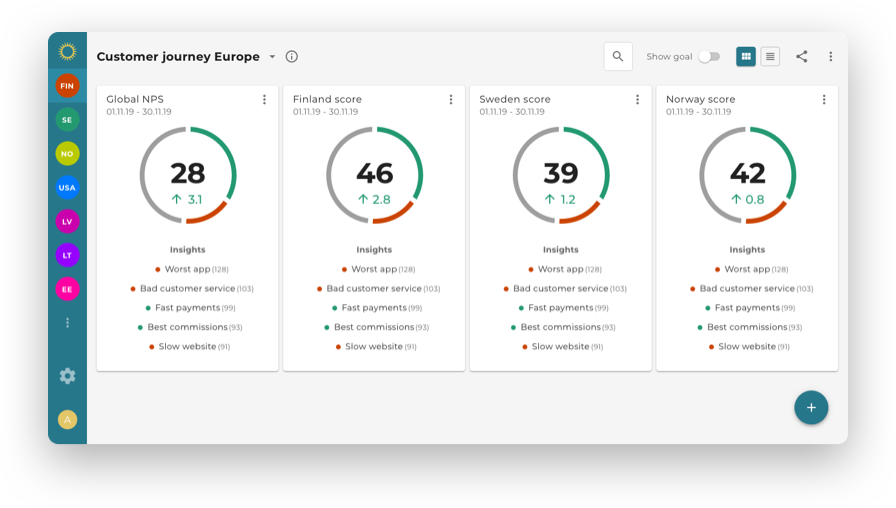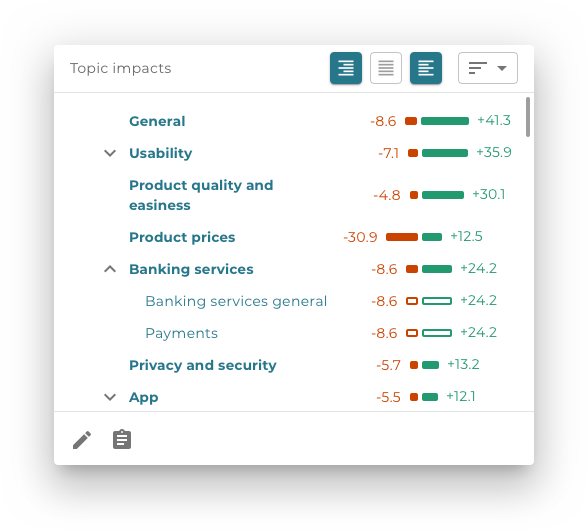How to Turn NPS Detractors Into Promoters

Last updated on August 7, 2023
“Your most unhappy customers are your greatest source of learning.” Bill Gates
No matter what industry you’re in or how excellent your products or services are, you’ll always have unsatisfied customers.
Unfortunately, it’s an inevitable part of doing business.
Unhappy customers can potentially damage your brand’s perception, spreading negative vibes about your business and seriously tarnishing your brand reputation.
In fact, a new study conducted by Oracle found that 88% of customers share their negative experiences with their friends and colleagues. According to the survey, only 35% will contact a company to give it a chance to resolve the issue.
But customer dissatisfaction doesn’t have to damage your business.
Studies show that 70% of complaining customers will return if their complaints are addressed, and up to 95% will return if their complaints are resolved quickly. That said, how can you turn your detractors into promoters? That’s what you’ll learn in this guide.
What Is a Detractor?
The Net Promoter Score® (NPS) framework is the most commonly used survey methodologies globally and is upheld as the gold standard for customer experience metrics.
Respondents are asked the question, “How likely are you to recommend ABC company/product to a friend or colleague?” and give a rating between 0 and 10.
Depending on their response, customers fall into one of these three categories used to establish an NPS score.
- Promoters (9 or 10) – Typically loyal and happy customers
- Passives (7 or 8) – Moderately satisfied with a brand and may switch to other brands if they provide better offerings
- Detractors (0 – 6) – These are customers who have had a negative experience with a brand and can negatively impact a brand’s reputation
For the purpose of this article, we’ll be focusing on detractors.
So, who is a detractor?
The Oxford dictionary defines a detractor as “a person who disparages someone or something.” In the business world, these are your unhappy customers who, if not attended to, can cause a severe dent in your brand image.
Detractors are the survey respondents who score between 0 and 6 on the NPS scale. They are your unsatisfied customers who will recommend against your brand.

Why Detractors are Not Good for Business
If you’re ignoring your detractors, thinking they are less compared to your promoters or whole customer base, then you’re leaving your business open to serious risk.
Detractors will leave negative reviews and spread bad word of mouth for your brand among the public. According to a survey by Lee Resources, for every 26 customers who leave your brand due to an unsatisfactory experience, one customer files a complaint.
And a single negative complaint on a major consumer complaints site, like Pissed Consumer, Complaints Board, or Better Business Bureau, can seriously hurt your reputation and bottom line. Here are a few reasons why detractors are not good for your business.
1. Detractors Bring Your Sales & Profits Down
Zendesk research shows that 80% will switch to a competitor after a bad experience.
And frustrated customers will have no reason to do business with you. In fact, 41% of customers will spend less money on a brand if they have a bad experience with it.
Your business will also lose money because you’ll need to find new customers to replace the ones you lost. And according to a Harvard Business Review report, acquiring a new client is up to twenty-five times more expensive than retaining an existing one.
Plus, the success rate of selling to a new customer is only between 5% and 20%. So, you could spend a fortune trying to find replacements for the distractors you lost and still fail to succeed. You might not even realize how much you have lost until it’s too late.
In contrast, the success rate of selling to existing customers is anywhere between 60% and 70%. So, focusing on customer retention is the better option.
2. Detractors Taint Your Brand Image
In an age where social media has become the de-facto medium for news and gossip, negative reviews can travel very fast when posted on these channels. A negative tweet can go viral in minutes, causing massive damage to your brand’s image.
Sprout Social research shows that 47% of consumers have used social media to complain about a business. The report reveals that most consumers call out brands on social media to make other people aware of potential issues.
And even outside of social media, detractors can cause a dent in your brand’s reputation via word of mouth. According to industry sources, 13% of frustrated customers share their experiences with 15 or more people.
In contrast, 72% of happy customers share their experiences with just six or more people. So, it’s evident that bad customer experience reaches twice as many ears as good experiences.

3. Detractors Help Your Competition
What’s the first thing detractors will do once they stop buying from you?
Find an alternative to your service, of course. And that’s where your competitors come in. They’re eagerly waiting to snatch your once loyal customers and make them their own!
And with 8 in 10 customers saying they’d switch to a competitor due to poor customer service, you’d better give your customers VIP treatment, lest they move to where the grass is greener. That said, your detractors are potential gold mines for the competition.
How to Turn Detractors into Promoters
Did you know that a 5% reduction in customer churn rate can increase profits by 25 to 95%?
Armed with this knowledge, what should you do to turn detractors into promoters? Here are four steps to help you turn an unhappy customer into a happy one.
1. Collect Feedback
The first step in turning detractors into promoters is understanding your customers.
Learn about what makes them tick. Dig deeper into their perception of your brand and figure out whether they’d recommend it to a friend or not.
In other words, launch an NPS survey.
Identify your detractors and understand what they think of your brand. Detractors are real people with real problems. Make sure you know their desired outcome and implement strategies to ensure they achieve it.
Don’t let the NPS survey be the only way – or the only time they can give feedback.
Instead, be available to provide customer support on their preferred channels.
Be it your website, social media, or mobile app—they should be able to provide feedback without having to fill out numerous forms. Also, continually remind them that those feedback channels are there for them to use.
2. Acknowledge & Apologize
Sounds awkward, but being humble is critical when dealing with an angry customer. It helps to bring their emotions down.
Your detractor customers are already unhappy with your brand or products. When they reach out to you, make sure you empathize with them and listen to their concerns. Customer empathy can help to create strong emotional bonds, even with unsatisfied customers.
Acknowledge the problem and apologize for any inconvenience caused. Don’t shy away from saying “sorry” for the bad experience they had with your products.

Also, don’t get defensive.
Resist the urge to defend, evade, or accuse when a customer is unsatisfied.
The goal is to resolve customers’ issues, not to inflict more frustration. If need be, find other ways to “wow” the customer, such as sending an apology card, gifting a coupon, or adding an additional month to their subscription.
3. Act on the Customer’s Feedback
Have you ever shopped on Amazon? If Yes, then you know how swift they are at handling customer disputes. Any problem with orders is resolved immediately.
They don’t even give you a chance to become a detractor. When you put the customer first like this, people talk. And nothing brings this point home more than what happened in 2008.
Amazon’s “put buyer’s first” policy was the headline of a 2008 New York Times article when one of its authors—Joe Nocera—ordered a PlayStation 3 console for his son.
The problem was, the PS didn’t come. When he tracked the package, he found that the item had not only been shipped but also delivered to his apartment building days earlier and signed for by one of his neighbors.
Even though Amazon had no fault in the theft, they promptly shipped another one and didn’t even charge him for the shipping.
While not every company can achieve this level of customer-centricity, there are a few things you can do to wow your customers and reduce the churn rate.
First, respond to customer complaints faster.
A recent study found that 82% of customers rate an immediate response when asking a product or marketing question as “important.” In the case of product defects, any delays in resolving customer queries will only give them time to defect to the competition.
Secondly, make them feel valued and cared for. Adopting strategies like free shipping can make your detractors feel loved and cared for—a great step towards turning them into promoters.
4. Close the Feedback Loop
Once you’ve prioritized and fixed the detractor’s issues, it’s time to follow up with them.
The feedback loop will close when you resolve the customer’s issue and update them about it. Therefore, once you’ve fixed the issue:
- Tell the customer you delivered on the promise
- Thank the customer for the feedback
- Ask for more feedback—that’s how you improve your products/services and make the customer journey ideal
And don’t resolve the issue for one person. Instead, remove it from the core such that no other customer will ever face the same problem again.
The fast track to promoters
Collecting and acting on feedback is a must if you want to have control over the customer experience and limit the number of detractors.
With tools like Lumoa, which are meant for collecting, analyzing, and taking action on customer feedback, it’s easy to keep track of your detractors. You can use Lumoa for any kind of feedback, such as NPS, CSAT, CES, or open text feedback.

You can easily identify the issues that make a customer a detractor, and opposite, you can see what are the things that delight your promoters. In addition, Lumoa also allows you to see what things drive your NPS up or down, and with how much. This makes it easy for you to know what are the biggest issues that need to be prioritized and fixed first.

Final Thoughts
Converting detractors into promoters isn’t easy.
However, it’s not impossible either. If you follow the tips mentioned in this guide, you’ll eventually be able to turn disgruntled customers into your brand advocates.